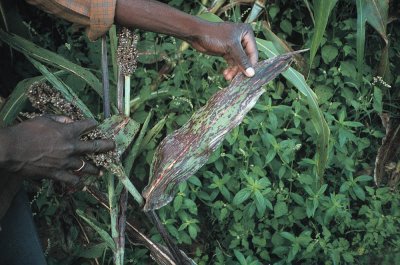(Colletotrichum graminicola)
Credits: Biovision-Infonet

(c) Courtesy EcoPort (http://www.ecoport.org): J.A. Frowd
The anthracnose fungus damages foliage and stems of grain sorghum. On susceptible hybrids, the stem holding the head (peduncle) becomes infected and a brown sunken area with distinct margins develops.
When infected stems are cut lengthwise with a knife, one can see that the fungus has penetrated the soft pith tissue and caused brick-red discolourations.
This peduncle infection inhibits the flow of water and nutrients to the grain causing poor grain development.
The fungus also invades individual grains and the small branches of the panicle. Rapid and severe yield loss can result from panicle and peduncle infections.
Leaf lesions are small, elliptical to circular, usually less than 0.9 cm in diameter.
These spots develop small, circular, straw-coloured centres with wide margins that may vary in colour from reddish to tan to blackish purple.
The spots may coalesce to form larger areas of infected tissue.
What to do:
- Use resistant hybrids.
- Rotate with non-cereals preferably with pulses.
- Good management of crop residues.